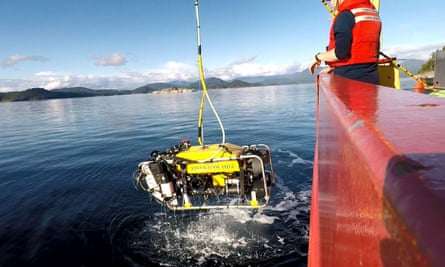D
Deep within the rough waters along the western coast of Canada, situated in a tight passageway enveloped by fjords, exists a coral reef that experts claim is not expected to be present. This reef, found in the northernmost region of the Pacific Ocean, presents scientists with a fresh perspective on the endurance and unpredictability of deep-sea ecosystems.
For many years, people from the Kitasoo Xai’xais and Heiltsuk First Nations communities near the Central Coast of British Columbia have observed significant gatherings of rockfish in a fjord system.
In 2021, a team of researchers and members of the First Nations partnered with the Canadian government to utilize a remote-operated underwater vehicle for exploration in the Finlayson Channel located approximately 300 miles northwest of Vancouver.
During the team’s final dive, they uncovered a surprising revelation, which was only shared with the public recently.
Cherisse Du Preez, who leads the deep-sea ecology program at Fisheries and Oceans Canada, recalls the initial skepticism among the team when they first caught sight of the living corals. However, as they continued to witness vast expanses of coral in front of them, all doubts were cast aside and feelings of pure joy and wonder took over.
Even though it was in complete darkness, the submersible’s lights were able to catch the vibrant shades of pink, yellow, and purple from the corals and sponges.
In the next year, the group charted Lophelia Reef, also known as q̓áuc̓íwísuxv by the Kitasoo Xai’xais and Heiltsuk First Nations. This reef is currently the only known active coral reef in the country.
The discovery marks the latest in a string of instances in which Indigenous knowledge has directed researchers to areas of scientific or historic importance. More than a decade ago, Inuk oral historian Louie Kamookak compared Inuit stories with explorers’ logbooks and journals to help locate Sir John Franklin’s lost ships, HMS Erebus and HMS Terror. In 2014, divers located the wreck of the Erebus in a spot Kamookak suggested they search, and using his directions found the Terror two years later.

Display the image in full screen mode.
The lophelia corals composing the reef are similar to those typically seen in the deep waters of the Atlantic and parts of the Pacific located south of California. Some of the largest reefs can cover extensive areas and take tens of thousands of years to fully develop. In the specific instance of q̓áuc̓íwísuxv, the reef encompasses 10 hectares (25 acres) of “thriving” corals.
Du Preez explains that the water in the Pacific is among the most ancient in the world, resulting in limited amounts of oxygen that pose challenges for the survival of coral.
The northern Pacific Ocean also experiences increased acidity, leading to the breakdown of coral’s calcium carbonate structures. The presence of essential reef-building materials was previously thought to be lacking in this region.
The group believes that the reef’s placement in a fjord where the water is particularly cold may be the reason for its prosperous state. The ridge where the coral exists is also situated in a zone where the water is mixed, allowing for well-oxygenated water to reach the coral.
Du Preez explains that although this particular reef may seem unique at first, it is unlikely to be the only one. This goes against the ways of nature. Thus, their next task is to locate and discover other similar reefs that undoubtedly exist.
Last week, the Canadian government’s department of fisheries stated that any fisheries utilizing bottom-contact methods, such as mid-water trawl, are prohibited from fishing in the reef’s vicinity, whether for commercial or recreational purposes.
Although steps have been taken to safeguard the region, the discovery of deceased coral at the edges of the reef emphasizes the distinct susceptibility of lophelia coral to rising temperatures and heightened acidity – indicators of a shifting climate.
According to Du Preez, the reefs are attached to the rock and if the foundation is broken down, they will detach and disintegrate into the ocean. However, by monitoring and regulating all the actions that take place in the vicinity, we can increase the likelihood of the reef’s survival in the face of climate change and potentially expanding to new locations.
In addition to the lophelia coral, scientists discovered a vast reef made up of glass sponges. It is improbable that these two species have encountered each other in any other location on the planet.
According to Du Preez, there are no regulations to follow in the depths of the ocean. This allows for the coexistence of different species, which may engage in conflicts or teamwork. Witnessing seemingly impossible occurrences in person is a thrilling experience for scientists.
Source: theguardian.com


